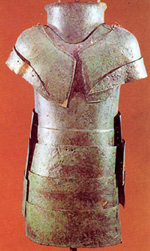 |
The Greek Age of Bronze
Armour |
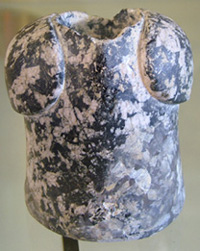 |
| The earliest element of an Achaean defensive armour is a bronze shoulder protection found in Dendra tomb 8 dated from LH I and LH II (1550-1500 BC). Originally described as a helmet it was later correctly identified as a right shoulder protection. The piece was found alone, without the rest of the armour, thus three hypothesis are possible: |
a) the entire armour had originally been placed into the tomb but later it was removed;
b)the guard had been placed alone in the tomb symbolizing the whole armour;
c)The guard belonged to an armour made of perishable material which disintegrated over the years.
We support the third possibility considering that examples of additions of a metal part to an armour consisting of other materials are quite numerous during the following period. Furthermore the assumption that the perishable material armour of tomb 8 only had metal on the right shoulder does not force us to an unnatural supposition since the warrior fought with his right hand and therefore needed particular protection for his exposed right arm.
Indeed a single metal shoulder guard used to protect the right shoulder has been also found in an Etruscan tomb in Italy. |
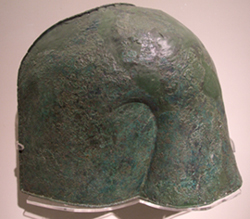 |
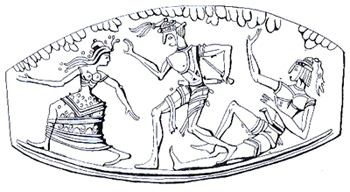 |
Possible evidence of a defence composed by a single shoulder guard is from a seal-stone from Thisbe Boeotia dated LH II (about 1500 BC). In this representation the standing warrior near the woman seems to wear a light cuirass with a single large right shoulder guard. Even if the autenticity of the seal-stones from the Thisbe "treasure of seals" is actually questionable their iconographic model are significant being more likely based on real specimens. |
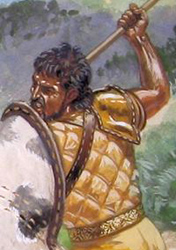 |
Based on the above mentioned elements a reasonable reconstruction of a perishable material cuirass reinforced with a single bronze shoulder guard can be assumed. |
| The most remarkable finding of an Achaean armour comes from the same location of the above mentioned shoulder protection. In the tomb n. 12 of Dendra dated between LH II and LH IIB (1450-1400 BC) a complete bronze armour composed by several elements was found. |
This defence consisted of: a)two bronze plates (*1) about 1 mm thick that protect the torso of the warrior; b)two bronze shoulder guards (similar but not equal in shape respect to the one from tomb 8);
c)two pieces of curved bronze plates attached to the underside of the shoulder guards to protect the upper arms; d)two triangular bronze pieces attached to the shoulder guards for additional protection at chest level; e)a bronze throat-guard; f)six bronze belts attached to the bottom edge of the cuirass three in front and three in back.
All parts show a series of small holes along the edges with a diameter of 2 mm used for attachment of a lining to the inside of the cuirass, this must have consisted of leather as leather remains have been found inside the plates. Parts of seam thread made of goat hair have been also found between some of the holes. Larger holes about 4 mm are also present near the edge of all the elements, these were used to attach the various plates to each other by means of leather laces. |
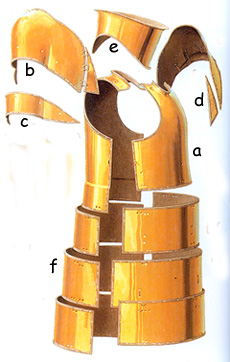 |
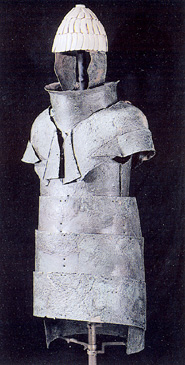 |
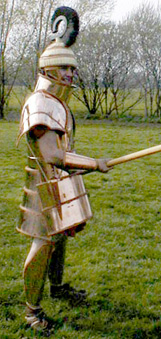 |
Some high fidelity reconstructions have demonstrate how this panoply, despite the huge aspect, was enough flexible and comfortable to be used also during fights on foot and not, as sometimes argued, exclusively by warriors fighting from the chariots.
This experimental reconstruction leads also to the conclusion that it allowed fighting with a sword and spear but not necessarily (because its large shoulder guard wings) with bow or javelin (*2). Fighting test conducted with a replica of this armour have in fact evidenced that the shoulder guards and their ancillary plates were designed to protect against circuitous attacks, that is, they were geared more towards defence against swords or daggers than spears. The high neck guard on this armour is an especially interesting feature in light of the fact that the "favorite" killing stroke with the longer Type C and D swords (see the page dedicated to the swords) , indeed one the most potentially lethal stroke, depicted in the iconographic record is precisely to this area of the body. Of course this not imply that armours were designed specifically to this end, but it certainly functioned to limit the range of attacks to which the long Achaean swords were suited in a battlefield context(*2a).
Possible evidence of this utilization is a metal ring, measuring 12 mm in diameter, attached to the middle of the right shoulder guard at its highest point probably meant to hold the strap for either a sword or a shield. Furthermore in the tomb near the armour pieces of wood with the remains of leather on reverse side had also been found, these elements could support the presence of a shield. An interesting features of this armour is the difference in the width of the armhole: the larger right armhole ensured freedom of movement for the warrior, who surely preferred his right arm in battle. This is another evidence, beside the presence of greaves and a singolar arm guard, that the Dendra armour was actually designed for operative use also for the ground fighting and not only for parade or for chariotters. |
A very bautiful and fully functional Dendra armour reconstruction has been made by Katsikis Dimitrios.
This reconstruction has been displayed in the 2018 in the EUREKA exposition of the Athen museum under the Acropolis. This and other reconstructions can be seen in the Katsikis Dimitrios beautiful web site HELLENIC ARMOURS |
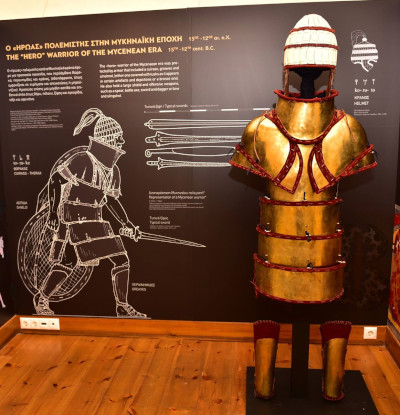 |
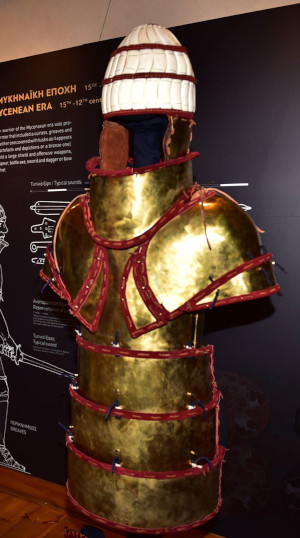 |
Because in some Near Eastern Iconography the chariot drivers seems sometimes equipped with a larger defence respect to the warriors some scholars suggest that also the Dendra armour could had been specificaly developed for such utilization. Indeed there are no elements in the Dendra tombs or in the Achaeans art representations which could support this theory.
The total weight of this panoply is around 15 to 18 Kg (about 33 to 40 lb). Considering the dimension of the breast plates and the analysis of the skeleton found in the tomb it has been establish that the "Dendra" warrior was 1.75 m tall (about 5'8'') (*3) but very slim around 60-65 Kg. (about 140 lb). |
On pottery the most clear representation of a warrior equipped with a "Dendra" style armour comes from a fragment from Mycenae dated LH IIIA or LH IIIB (1350-1300 BC). In this image an embossed or decorated cuirass with a large neck protection is recognizable. The four horizontal trips could be explain both as decorations or segmental plates (see bellow mentioned findings). The pottery is likely representing a fighting scene being a falling sword visible in front of the warrior. Unfortunately from this fragment it is not possible to identify whether the warrior is fighting on foot or from a chariot.
Indeed this is a clear evidence that the "Dendra" style armour were used for active fights and not only by chariot's driver. |
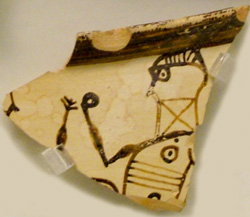 |
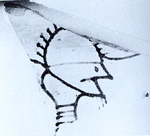 |
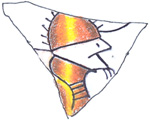 |
In another krater's fragment from Mycenae dated around LH IIIC (1200 BC) a soldier seems to wear a cuirass equipped with a "Dendra" style neck guard. Also in this case the longitudinal strips could be interpreted as decorations or more likely elements of a segmental armour.
The bronze colored drawing could be useful in the visualization of the armour's various elements. |
| From a very schematic image on a pottery fragment from Tiryns dated LH IIIB2 or LH IIIC (1250-1200 BC) two charioteers seem equipped with rigid neck protections. The poor status of the fragment and the very schematic style of the artist do not allows the identification of any other elements. |
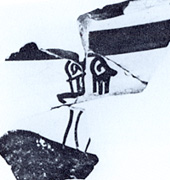 |
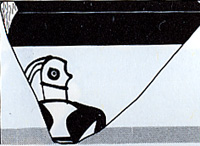 |
Also in this krater's fragment from Tiryns dated around LH IIIB2 (1250 BC) a soldier seems to wear a cuirass equipped with a "Dendra" style neck guard. |
| Others very important evidences of Achaean armour come from the Kadmeia, the Achaean citadel of Thebes in Boeotia (*4). These elements dated LH IIIA/B2 (about 1350- 1250 BC) are so far the only ones found in the storerooms "Arsenal" or annexes of a palace, instead of inside a warrior's grave. The bronze elements, not necessarily parts of a single armour, are the following: |
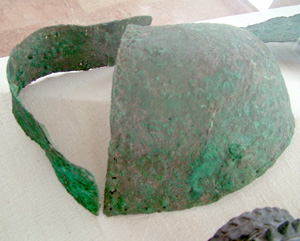 |
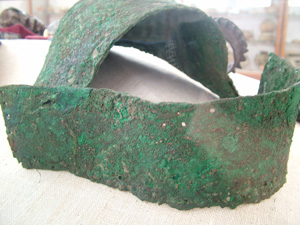 |
a)A pair of shoulder guards, smaller respect to the ones of Dendra armour. The Theban specimens lack the wide "wings" that cover the Dendra cuirass at chest and back.b)Two upper arms protection attached on lower edge of the shoulder guards. All these element have small holes 2 mm in diameter along the edges for attachment of a lining to the inside and bigger holes 3-4 mm used to attach the elements to each other by means of leather laces. |
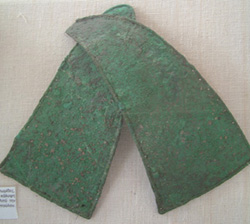 |
c)Two triangular breast shields (277 mm long) only with a series of small holes 2 mm in diameter along the edges. Because no bigger holes seem to be present these elements were probably parts of a non metallic armour reinforced with bronze elements directly attached to an inner perishable material cuirass. |
| d)44 fragments of band sheets with a series of small holes 2 mm in diameter along the edge. Bigger holes 3-4 mm in diameter are also present in the larger fragments used to attach the elements to each other or in the lower edge of the torso cuirass by means of leather laces. Because the similitude with the Dendra specimens these bands are probably belts for the protection of the lower part of the body, as the excavators stated, although their width is half or even one third of these of the Dendra cuirass. |
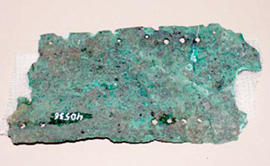 |
| Because no bigger holes seems to be present on the smaller fragments these were probably reinforcement elements of a non metallic cuirass directly attached to an inner perishable material corselet. |
 |
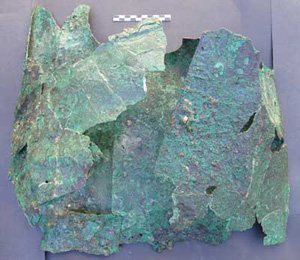 |
e)A bronze cuirass from the NW area of the Thebes palace. This specimen is incompletely preserved. Missing are the shoulders and part of the right lateral side. The breast and back plate are fastened with two double-headed nails, following the arrangement of the plates at Dendra cuirass. At the right edge of the breast plate there is a loop for fastening of the cuirass after it has been put on. The lower edge of the cuirass is continuous, without the back plate being longer. Furthermore the edges are plain without being rolled as at Dendra cuirass. Along all the edges there is a series of small holes 2 mm in diameter used for attachment of a lining to the inside of the cuirass as well as bigger holes 3-4 mm in diameter in pairs or triads along the lower edge used for attachment of the protection belts.
f)One fragment of shoulder guard and one breast shield have also been tentatively recognized, among the numerous fragments of bronze sheets found together the cuirass. |
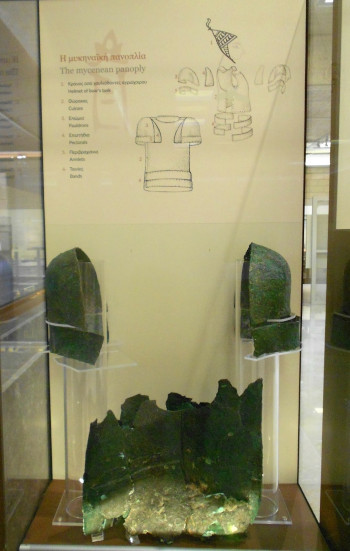 |
The above mentioned Thebes armour, shoulder guards and upper arm protection are properly displayed in Thebes Archaeological Museum. |
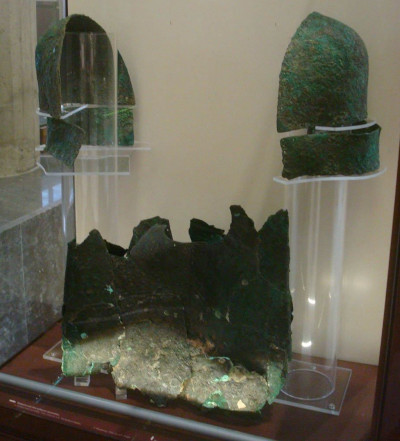 |
| Based on the elements from Thebes a reasonable images of an Achaean armour composed by torso cuirass with front and back plates, shoulder protections, (with or without the upper arm protections) and belt plates (also in this case these could have been obmitted or installed in different quantity of two, four, or six based on warrior personal choice) can be reconstructed. The symbol near the armour drawing is a linear B ideogram which shows similarity with this type of armour. The bronze war bracelet, also found in Thebes, is described in the page dedicated to the arm guards and greaves. |
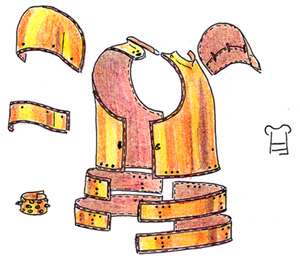 |
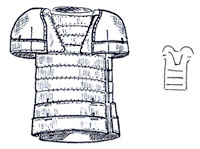 |
Always based on the small bronze strips and breast protections from Thebes a segmental armour made of perishable material with bronze reinforcements can be reasonably assumed. Also in this case shoulder guards, upper arm protections and belts in variable quantity can be also applied. The symbol near the armour drawing is another linear B ideogram which shows possible similarity with this type of panoply. |
| Of course not necessarily the bronze protection plates must had been located on the entire armour. A non metallic cuirass reinforced with some of the bronze plates found in Thebes only placed in the chest and scapulae area with shoulder protections and belts can be reasonably assumed as well. |
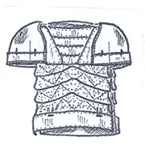 |
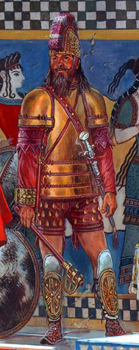 |
 |
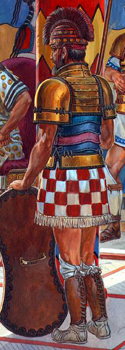 |
A beautiful reconstruction of these three armours based on the Thebes findings has been made by Andrea Salimbeti and Raffaele D'Amato with the drawing of Igor Dzis for the relevant article published on ANCIENT WARFARE VOL. III ISSUE 3 June/July 2009. |
| 117 fragment of bronze plates dated around LH IIIA-LHIIIB2 (about 1370-1250 BC) have been found during the excavations in a tholos tomb at Nichoria in Messenia. These elements are very likely parts of a segmental armour. Some of these plates have edges that are rolled to the outside and there are small holes 1 to 2 mm in diameter along the edges for attaching a perishable material lining. These holes are ca. 15 mm apart. They are clearly punched, without ragged edges on the interior. Some of the holes are not located below the edge of the metal but are actually along it. so the stitching holding the leather lining would not have been secure at their points. This would also seem to indicate that the holes were punched after the leather lining had been pulled over the edge of the metal, obscuring the workman view. |
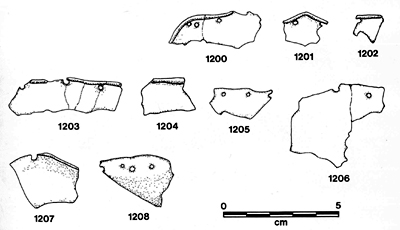 |
| Other pieces of these elements have slightly larger holes that are pierced somewhat farther from the edge than the smaller ones that attached the lining. All the larger holes have ragged edge, as if the holes had been punched from the exterior without a solid surface behind the plate. Because each warrior had to custom-fit his armour after he acquired it in order to adjust for his height, the larger holes may not have been punched by the craftsman who fashioned the armour but by the warrior himself (or an assistant). |
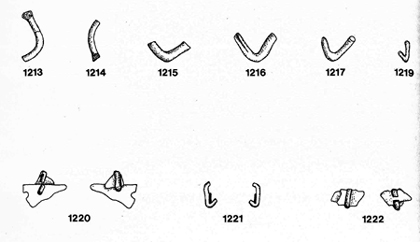 |
Pieces of heavy bronze wire that could have formed the loops joints the left side of a breastplate to the backplate of an armour are among the fragments from the tholos. Yet this bronze wire admittedly could have served many other functions.
Four small staples from the tholos floor may also belong to the armour. The ends of both intact staples are bent back toward the center of the staple, and the others seem to have had the same configuration. In three of the staples there are still fragments of bronze plate of the same thickness as the body armour. One of the plate fragments has a hole that was probably used for attaching the plate to another type of material. |
| A group of ca. 150 similar staples in copper have been also found in Tomb V at the New Hospital Site at Knossos. As the excavators believed these staples may have probably fastened the body shield ox hide layers to each others or to its wooden frame. Somewhat later, however, after the discovery of similar fragments in a warrior grave near Ayios Ioannis it has been also suggested that because of their blunt ends the staples were more suited to attaching leather to leather, as in a helmet. The function of the staples from the Nichoria tholos, however, seems to be clearer. As the pieces of bronze plate attached to them indicate, the staples were used to join one piece of bronze to another. A partially preserved hole in one of the pieces of plate indicates that the plates, once joined, were then attached to another kind of material. Thus they could well be pieces from a metal-segmental armour.
| 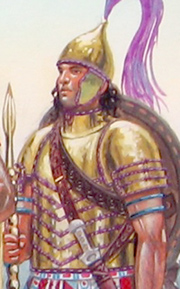 |
The recognizable armour plate fragments were found scattered throughout the stomion and tomb chamber. Some even came from the fill between the blocks in the wall at the entrance to the tomb. Because of their preence in the fill and in the blocking wall, it is clear that the armour was removed rather early in the history of the tomb. It may even have belonged to the ruler who built the tomb and was one of the first to be buried in it.
Because bronze body armour must have been extremely valuable, it is likely to have been handed down from one generation to the next, until it was destroyed rather than buried in a warrior's tomb. Once it was placed in a tomb, however, it probably would have decayed easily owing to the thinness of the metal plate. The apparent value placed on bronze combined with the thinness of the metal plate used in body armour suggests, therefore, that the discovery of a complete cuirass should be a rare event. And in fact only a small number of fragments or parts of body armour can be recognized aside from those in the Dendra tomb, Thebes palace and Nichoria tomb. |
| Atop the wood coffin of a rich warrior shaft grave in Pylos dated about 1550-1420 BC several thin bands of bronze, probably from the warrior's suit of body armor have been found together bronze jugs, bronze basin and many wild boar's teeth from the warrior's helmet. |
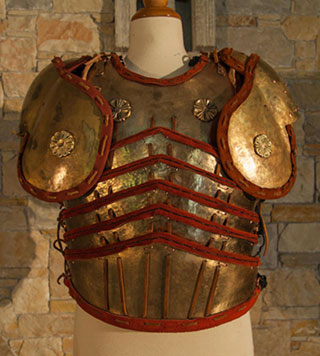 |
A very interesting and fully functional bronze reconstruction of a possible segmental Late Bronze Age armour has been made by Katsikis Dimitrios.
This reconstruction and other bronze and leather armours, corselets, helmets, shields, greaves, swords, axes, etc.. from Bronze Age till Bizantine period are displayed and available from Katsikis Dimitrios beautiful web site HELLENIC ARMOURS |
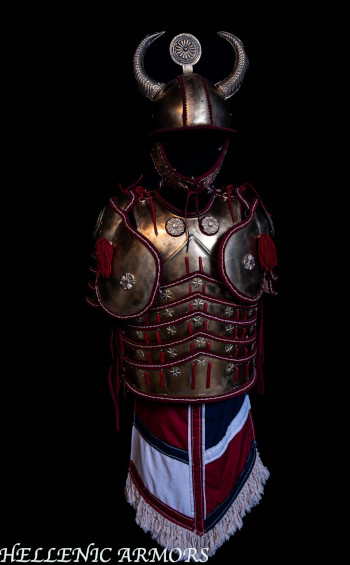 |
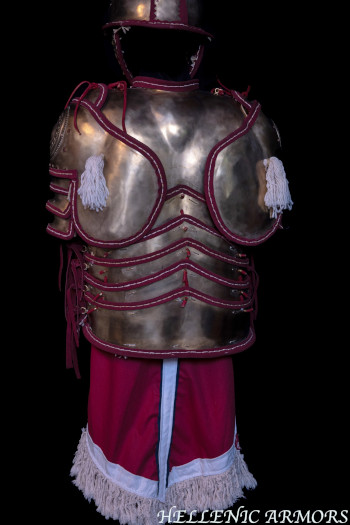 |
Another bronze reconstruction of an hypothetical segmental Late Bronze Age armour has been also made by Katsikis Dimitrios.
This reconstruction and other bronze and leather armours, corselets, helmets, shields, greaves, swords, axes, etc.. of the late Bronze Age period are displayed and available from Katsikis Dimitrios beautiful web site page SEA PEOPLE ARMOUR |
Several fragments of bronze band sheets similar to the above mentioned have been found in some others Achaeans tombs as follow:
a)Two fragments of band sheets, one gilded and one curved that appears to be grom a girdle, (large respectively 55 and 60 mm) from Mycenae chamber tomb 58 and 69 dated LH IIIA/B1 (1350-1300 BC). All these band sheets shown small holes around the edges. |
 |
 |
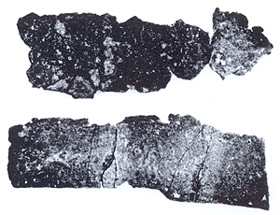 |
 |
b)Two fragments of band sheets (large respectively 60 and 80 mm) from Mycenae chamber tomb 15 dated LH IIIA/B1 (1350-1300 BC). Also in these specimens some of the small holes around the edges are still visible. |
| c)Two fragments of copper trapezoidal plates (respectively 48 mm x 35 mm and 50 mm x 42 mm) with holes around the edges with traces of quadruple linen or hemp thread that fastened the copper to a linen backing have been found in Phaistos Crete "Tombe dei Nobili" dated LH IIB. From the same tomb there is also another copper plate fragment (295 mm x 120 mm) also with small holes for sewing the metal to some sort of backing and appears to belong to a cuirass.
These elements have been variously interpreted as belts, breast protections or parts of "mitra"(*5). Undoubtedly these elements are related to the ones from the "Arsenal" in Kadmeia and probably to the o-pa-wo-ta ("things hung or attached around") mentioned in some linear B tablets from Pylos (see the dedicated section below ) |
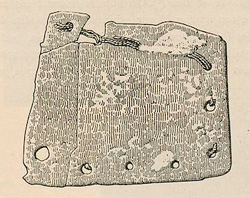 |
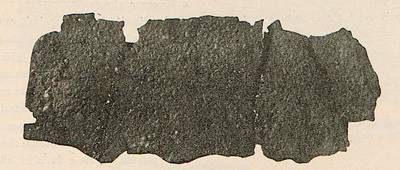 |
d)In the chamber graves 519 and 529 from Mycenae dated LH II reutilized in LH III some fragments of bronze sheet have been found. This is a confirmation of how the graves originally contain bronze armour which have been destroyed or damaged during the graves further utilization.
e)In Pylos palace several small bronze fragments with some barely visible embossed elements have been found. These are probably remains of cuirass or reinforcement elements of corselet dated around LH IIIB.
|
| A possible representation of an early cuirass is attested in this statue from Kannia near Gortina dated before the Cretan palaces destruction (about 1400-1450 BC). It seems to represent a warrior equipped with a rigid bell-shaped cuirass with a lower trimmed edge probaly coming from a garment worn under the cuirass. |
| 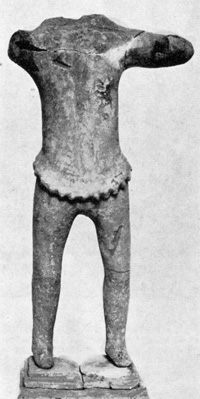 |
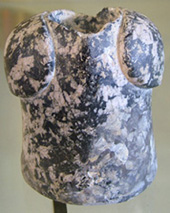 |
A beautiful example of an Achaean armour is from a stone vessel in shape of cuirass from a tomb in Knossos dated around 1350 BC. In this representation the shoulder guards are clearly identified and because of their shape these could be related to the ones from Thebes. |
|
| A possible representation of cuirass with embossements at chest level is attested on this sculpure from the Achaean settlement in Maa-Palaeokastro Cyprus dated arond 1200 BC. |
| 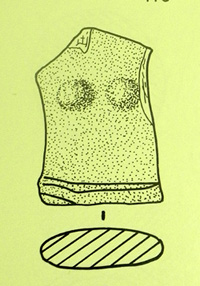 |
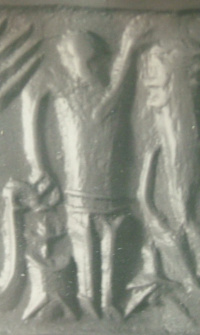 |
A possible representation of cuirass with lower protection band is shown on a seal from Cyprus dated arond 1300 BC. |
|
| Two bronze statuettes respectively from Thermos and from the sanctuary of the Ingot God at Enkomi Cyprus dated about 1200 BC show warriors which because of the two embossements at chest level seem to be equipped with bronze cuirass.
|
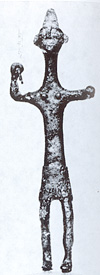 |
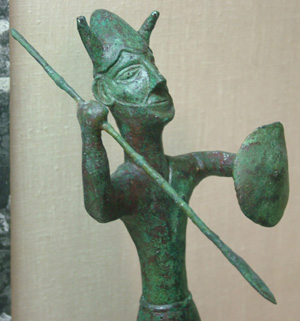 |
| On iconography we have several evidences of images which could be related to warriors wearing bronze armour. Unfortunately being mostly of these drawings strongly stylized it is sometime difficult their interpretation, or the correct identification of the type of defence and if the represented armour were made of metal or non-metallic material.
|
|
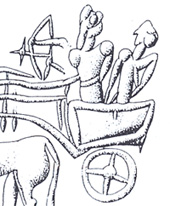 |
On an Achaean-Cypriote seal from Cyprus dated XV-XIV century BC two warriors on chariot are represented. The one handling the bow seems to wear a defence with shoulder protections and belt. One shoulder protection is also identifiable on the chariot driver. |
|
| In a color pottery fragment from Mycenae dated LH IIIC a warrior behind a horse whose reins he is holding is depicted. The linear design on the body could represent a segmental armour made of perishable material reinforced with bronze plates.
|
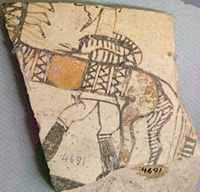 |
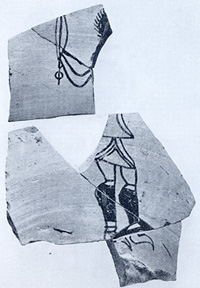 |
In a krater fragment from Tiryns dated LH IIIC a warrior seems to wear a bell-shaper cuirass. A decorate or reinforced lower abdomen protection "mitra" is also visible. |
|
| In another fragment from Tiryns dated LH IIIC the lower edge of a bell-shaped cuirass is recognizable as well as a possible waist belt.
|
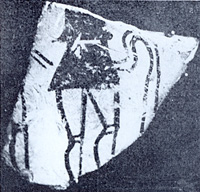 |
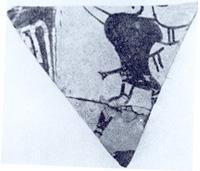 |
In this krater fragment from Leukandi dated LH IIIC a warrior is depicted with a large body defence possible reprentation of a bronze cuirass and relevant shoulder guards. |
|
| The charioteer represented in this pottery fragment from Tiryns dated LH IIIB2 seems wearing a rigid cuirass with two bosses at chest level.
|
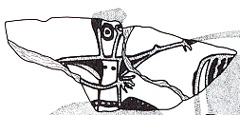 |
 |
On this small krater fragment from Tiryns dated LH IIIC a lower part of a cuirass or the relevant protection belt and a fringed "Kiton" can be identify. |
|
| In another fragment also from Tiryns dated LH IIIC The lower belts of an embossed cuirass are more likely represented.The vertical segmental motif remind the type of band sheets found in Mycenae.
|
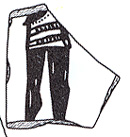 |
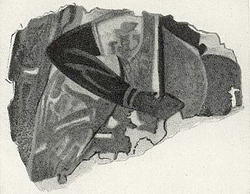 |
A body defence without the shoulder guards seems to be also worn by a warrior represented on a fresco fragment from Mycenae dated around 1350 BC
|
| A decorated or embossed defence seems to be represented in this pottery fragment from Tiryns dated LH IIIB. In this case a neck guard seems to be present as well.
|
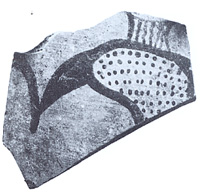 |
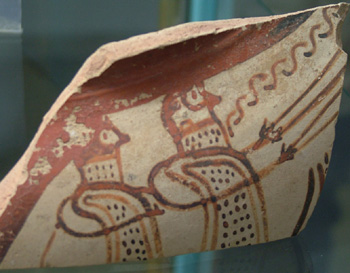 |
Another similar embossed armours with neck protection seems also worn by the two men on chariot depicted on this Achaean krater fragment from Cyprus dated 1400-1300 BC
|
| A possible warrior with cuirass or corselet with neck protections seems depicted on this pottery from Nemea dated LH IIIA2 (about 1350-1300 BC)
|
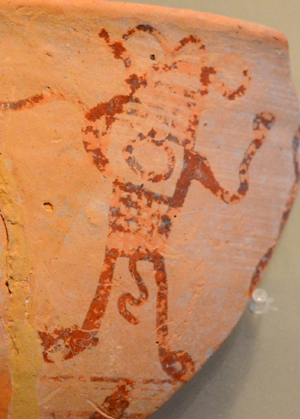 |
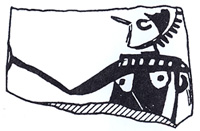 |
On this krater fragment from Iolkos dated LH IIIC a warrior wears a defence which seems to be compoused by reinforcement plates on chest and upper part of the corselet. Probably also in this case the armour is made of a non-metallic material reiforced with bronze plates. |
|
| In another fragment of the same krater from Iolkos a similar type of defence is worn by the warrior on the right side. The soldier on the left is equipped with a neck protection which seems much smaller and confortable respect to the one of the armour found in "Dendra".
|
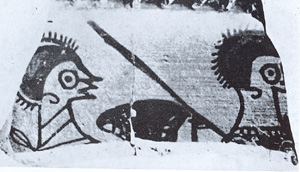 |
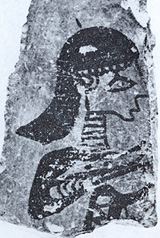 |
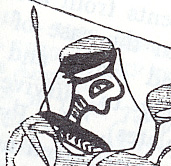 |
Small neck protections are also worn by the warriors represented in these paintings from Tiryns dated LH IIIC. These protections not necessarily are related with a cuirass but could have been additional elements worn with any kind of defence. |
|
| Similar neck protections are also represented in some bronze statuettes of warriors from the island of Sardinia Italy dated around IX century BC. |
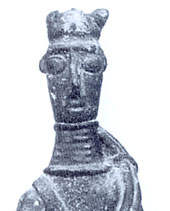 |
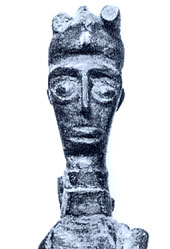 |
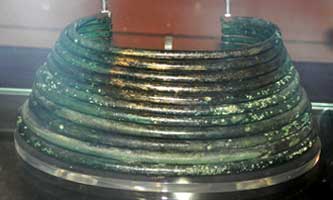 |
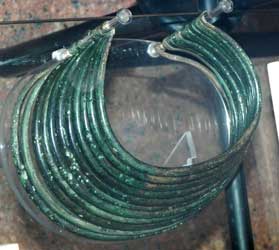 |
In fact this kind of neck protection made of several bronze rings dated 2000-1600 BC has been actually found in Italy |
|
| Even if the defence shown on the famous "warriors vase" and stele from Mycenae dated LH IIIC are generaly interpreted as non-metallic corselet, we can't completelly exclude the hypothesis that the warriors' torso was protected by a metal cuirass similar to the one found in Thebes. Additional "poncho" style corselet only made of linen or with metallic reinforcements seems to be present over the cuirass and a "mitra" is probably hanging from the belt.(further hypotesis, details and findings related to these representations are show in the pages dedicated to the corselet, scale armour and Iliad armour)
|
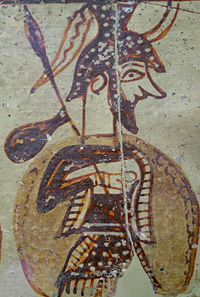 |
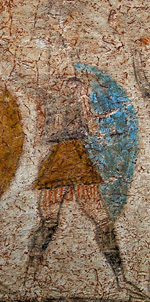 |
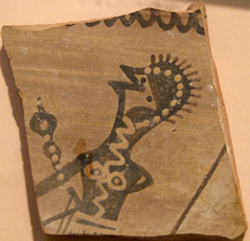 |
In a pottery fragment dated LH IIIC (about 1200-1100 BC) found in Voudeni near Patras an achaean warrior is probably wearing a bronze cuirass on which two circular embossed at chest level seems to be depicted.
The central curved white motif could represent the shining effect of the metal armour, in this case the warrior could have been probably also equipped with a neck protection.
|
| On two pottery fragments from Naxos dated LH IIC a duel between two warriors is represented. The warrior on the left could worn a bronze cuirass and some kind of banded protections on lower body and legs. The warrior on the right seems equipped with a tiara like helmet (see also the pages dedicated to the late helmet and the Sea People). |
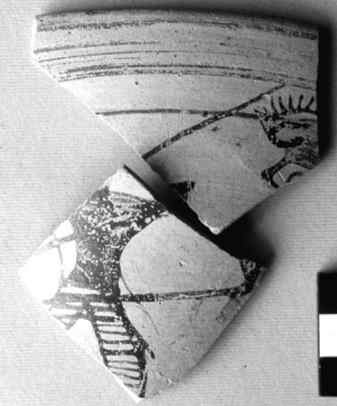 |
| Segmental armour or corselet made of bronze bands or perishable material reinforced with bronze elements and shoulder protections similar to the ones found in the Achaeans settlements, are more likely worn by the "Sea Peoples" Sherden and Peleset as represented in the Medinet Habu Egyptian temple. (see also the page dedicated to the Sea People). |
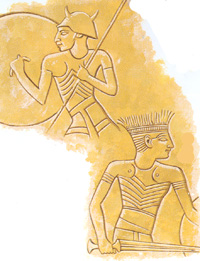 |
| ARMOUR IN THE LINEAR B
|
The above mentioned findings at Dendra, Thebes, Mycenae, Phaistos and Knossos support the identification of the armour-ideograms present on some of the 140 linear B tablets from Knossos (category SC) dated LH IIIA (around 1350 BC) and on 12 tablets from Pylos (category Sh) dated LH IIIB2 (around 1250 BC).
On the Pylos tablets we also have the inscription to-ra-ke which leaves no doubt about the identity of the object.
In the Knossos tablet Sk 206 is also present the inscription to-ra followed by the description of the armour composed by two plates, two shoulder guards and two "suspended elements". In some other Knossos tablets (category SK and K) the inscription qe-ro2 is also show which seems to be related to cuirass as well even if more likely this word and the relevant symbol indicate the two reinforcement bronze plates of a non metallic corselet (see also the page dedicated to the corselet).
|
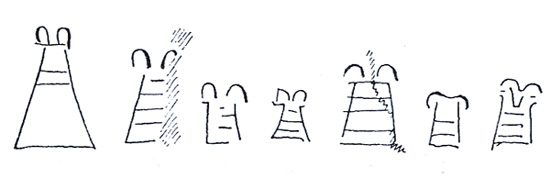
ideograms from Knossos |
The various armour ideograms from Knossos have common characteristic such as the trapeze form of the ideogram, the variable number of horizontal lines and the curved lines above the shoulders curved like loops which clearly illustrate the shoulder pieces corresponding to those of Dendra and Thebes. The word e-po-mi-jo on the tablets from Knossos proves that shoulder pieces formed part of the Achaean-Cretan armour, like demonstrate by the stone vessel in shape of cuirass from Knossos. The horizontal lines could identify the elements (cuirass and belts) of a Dendra or Thebes style armour as well as the reinforcement bands and belts of the segmental armour as for some of the findings in Thebes, Mycenae, and Phaistos. Furthermore the sign on the chest of the last ideogram of the above image could be interpreted as the two triangular breast protection found in Thebes or the two small triangular breast protection of the Dendra armour. The ideogram from Knossos are not followed by the list of the elements o-pa-wo-ta as for the ones from Pylos this could means that the Knossos ideograms alone was sufficient to indicate the complete armour.
The Pylos tablet Sh 740 reports five old panoplies pa-ra-jo (composed by armour plus helmet) to be restored. The tablet Sh 736 also from Pilos is the document of the restored equipment (armours and helmets are now indicated as ne-wo)
|
A linear B fragment from Tiryns dated around 1300 BC shows two armour ideograms similar to the ones from Knossos. Also in this case the horizontal lines identify the armour's belts are visible as well as the two curved lines for the shoulder guards. In this ideogram also the neck protection and the conical helmet seem to be represented. The general shape of these signs show close similarity with a " Dendra" style armour.
In Tiryns the tablet Si 5 records twp panoplies (armour plus helmet) |
| 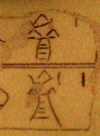
ideograms from Tiryns |
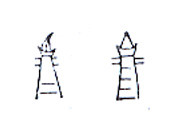
ideograms from Pylos |
The Pylos ideograms show sharp differences respect to ones from Knossos and Tiryns. a)Instead of the curved lines above the shoulder two thin straight lines extending out from the sides of the upper part of the ideograms are depicted. b) An additional upper part over the shoulder is representing to indicate the neck protection element as well as conical element probably indicate the presence of a helmet is also present. |
|
| Even if in their general shape the Linear B ideograms from Pylos could recall a Dendra style armour the following elements do not support this theory: On 11 of these tablets the ideogram is followed by the number of the "accessories" o-pa-wo-ta (things hung or attached around), in some cases each armour is listed as having twenty large and ten small "accessories" in four cases the number are even slightly higher twenty-two large and twelve small. Obviously the number of these "accessories" is too high to be compatible with the elements of a Dendra style armour. Furthermore in the tablets from Pylos the e-po-mi-jo (shoulder guard) are not listed neither in the text nor in the ideogram.
In the tablet Sh 736 the term to-ra-ke is also present as well as the indication of the helmet's components four or two o-pa-wo-ta and two cheek pieces pa-ra-wa-jo (*6) (see also late helmets dedicated page).
Also in this case it is clear because of the Achaean meticulousness in their registration that the ideogram itself indicate a complete armour with the helmet where the relevant "accessories" in variable quantity are added. The ideogram images without shoulders guard with the indication of sleeves recall the images of a non metallic sleeved "Kiton" reinforced with several bronze o-pa-wo-ta. The material is not specified, but one table hints at linen.
|
| Based on the Pylos ideogram we can thus suppose the possible aspect of a perishable material armour or corselet reinforced with 30 or 34 o-pa-wo-ta also equipped with a neck guard. The bronze reinforcement elements are obviusly based on the several plates or strips found in Thebes, Mycenae, Nichoria and Phaistos.
|
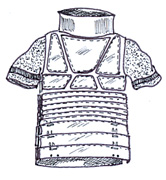 |
| CENTRAL EUROPE CUIRASSES
|
| From the rest of Europe worthy to be mentioned are some cuirasses found in Slovakia, Hungary and Italy because their vicinity with the Achaean mainland and because they fall to the same time period as the Greek Bronze Age civilization, either before or after the collapse of the palace system.
|
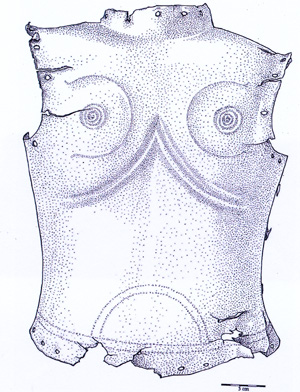 |
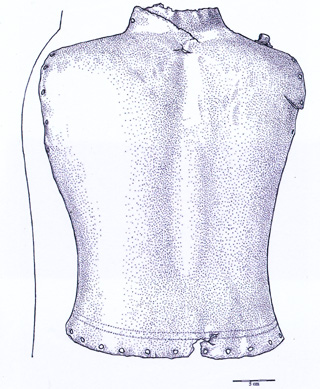 |
a)A complete and well preserved bronze cuirass found in the Danube near Pilismarot Hungary dated about 1300-1100 BC.
This cuirass show actuall damaged occurred during the fighting.
|
| b)Many fragments of a sheet bronze cuirass with decorative bosses and rivets in the breast area where the star motif appears. From Caka Okr, Levice Slovakia dated around 1250 BC.
|
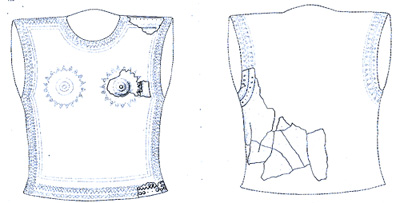 |
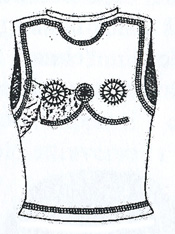 |
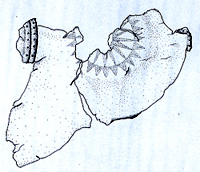 |
c)Fragment of the breast plate of a cuirass from Ducovè Okv. Trencin Slovakia dated around 1250 BC. Also in this case decorated on chest with the star motif.
This star motif is very similar to the one present in the Achaean bronze, disk probably part of a corselet, found in a warrior grave in Pylos dated around 1500-1420 BC. This element support the hypothesis of the Aegean origin of some Slovakia cuirasses of the late Bronze Age.
|
| d)Fragmentary cuirass from Cierna nad Tisou Slovakia dated 1050 to 950 BC. Biggest part of the back plate and a small one of the breast plate are preserved. This cuirass is plain except for the ridges parallel to the edges.
|
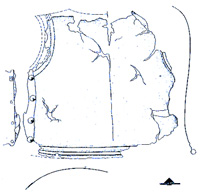 |
e)Two fragment dated 12th century BC of a cuirass plate from Szentgalosker Hungary decorated with applied bronze sheet.
f)Fragment of cuirass paltes with ridges along the rolled edges from Nadap Hungary dated around 1250 BC.
g)Fragment of cuirass plates from Farkasgypu Bakony dated around 1250 BC.
h)Several fragments of a cuirass from Pila del Bracon Nogara Italy dated around 1250 BC.
These above mentioned examples are very fragmentary to be considered valid their restoration as "bell-shaped" cuirasses. The best preserved one is basically of cylindrical shape although its lower part turns outwards. Apart from the shape, the similarity to the Achaean so far discovered cuirasses is underlined by the plainess of the surface, the firm fastening with nails on the left side and the rolled edges.
|
| CONCLUSION
|
| Based on the large number of findings, art representations and linear B descriptions we can conclude that the bronze armour had a wide and uninterrupted use in Bronze Age Aegean world starting from the 15th century BC till the fall of the Achaean civilization. The efficiency of the bronze cuirass to protect from swords lashes especially in comparison to linen or leather corselet, has often been questionable. Consequently, it has been suggested that it was restricted to the display of prestige. The findings have demonstate that this theory is not valid, since the bronze cuirasses were strengthened with a inner linen cloth lining, thus gaining in efficiency. Additional it is now clear that, since the first Dendra speciment, pratical improvements were applied to the Achaean armour towards simpler and smaller forms in order to increase their confortability, flexibility, and possibility to be accomodate in different variants depending from warriors' personal necessity.
The various findings seem to be correlated mainly with two type of Achaean bronze armour: the first one was based on rigid two plates breast cuirass where additional protections variable in quantity could have been attached (shoulder guards, upper arm protections, neck protections, belts and "mitra"). The second one seems more likely based on a non-metallic corselet on which several bronze elements o-pa-wo-ta were attached to increase protection in general or in dedicated area of warrior's body. Also for this more confortable and flexible defence the possibility to add additional elements like Shoulder guards, neck protection and belts seem to be reasonable.
On the "Chariots tablets" from Knossos the individual warrior's equipment given by the palace administration is indicated. The entity of this "palace supplied equipments" (two horses and two cuirasses) is much more evident considering the entire corpus of these tablets (*7), indeed to each warriors only the elements necessary to complete his equipments were given. For instance only one cuirass or one horse if the warrior already had one in his personal dotation. This was probably valid also for what concern the armour components, we can thus suppose that in some cases only some o-pa-wo-ta (things hung or attached around), qe-ro2 (breast plate) or e-po-mi-jo (shoulder protections) were given in order to complete the two warrior defences. In these and other similar cases we can suppose that the warrior already had the supplementary elements and for this reason are not listed in the relevant tablet.
The linear B word a-ki-re-u, probably Achaean origin of the name Achilles (*9), seems to be related to a person "equipped with own defence".
From these elements is undubfull that the Achaean armour is connected to the hierarchically organized state with the palace at its center. The palatial authority, as the linear B tablets inform us, provided seleced persons with defences and equipments, presumably the members of a military elite, who paid back through their obedience and support to this centripetal system (8*).
|
(*2) D.E.H. WARBLE, Does reconstruction help? A mycenaean dress and the Dendra suit of armour in E.B. FRENCH and K.A. WARBLE Problems in Greek Prehistory (1988) 474-476, pl.30.
|
(*2a) BARRY MOLLOY, Martial arts and materially: a combat archaeology perspective on Aegean swords of the fifteenth and fourteenth centuries BC. World Archaeology Vol. 40(1): 116-134
|
(*3) This correspond well with what we know about the very height of the Achaeans. In the grave circles A and B of Mycenae the average height of the men was 1.71 m (about 5'6'') and at least three of them were over 1.80 m (up to 6 feet!)
|
(*4)A detailed analysis of these elements have been made for the first time by Dr Eleni Andrikou (Hellenic Ministry of Culture) in a conference held in Zagreb on June 2005. The complete article has been also published on AEGAEUM n° 27 BETWEEN THE AEGEAN AND BALTIC SEAS. PREHISTORY ACROSS BORDERS (2007).
A complete article about the Thebes armour with a full colour reconstructive table has been published by Andrea Salimbeti and Raffaele D'Amato in the ANCIENT WARFARE VOL. III ISSUE 3 June/July 2009. |
(*6)In these tablets the helmet has always a genitive indication as specification of the o-pa-wo-ta while in the SK category from Knossos it has a nominative indication. This because in the Pylos tablets was not necessary include the helmet in the list because already shown in the ideogram.
|
(*7)Only three tables from Knossos provided the decription of a full equipment: Sc 217, Sc 5060 + 5140 and probably Sc 231.
|
| (*8)CASSOLA GUIDA Le armi difensive dei micenei nelle figurazioni 58-59; S.DEGER-JALKOTZY Military Prowess and Social Status in Mycenaean Greece. Actes de la 7e Rencontre égéenne internationale, Université de Liége, 14-17 avril 1998, Aegaeum 19 (1999) I, 124, 126-127; MYLONAS-SHEAR Kingship in the Mycenaean World and its Reflections in the Oral Tradition (2004) |
|